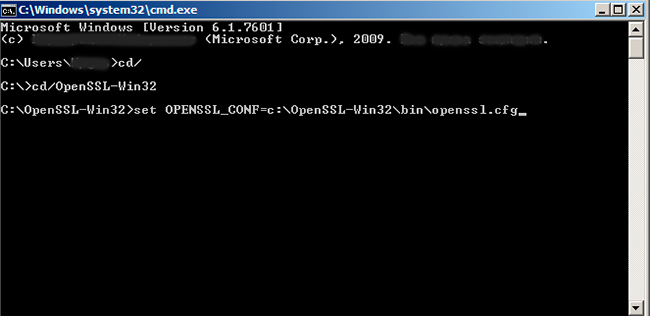Let's say I have an RSA (2048) keypair that I generated private.key public.key For testing purposes I'd like to generate a self-signed X509 certificate. My understanding of a certificate is that. Oct 25, 2019 Common OpenSSL Commands with Keys and Certificates. Generate RSA private key with certificate in a single command openssl req -x509 -newkey rsa:4096 -sha256 -keyout example.key -out example.crt -subj '/CN=example.com' -days 3650 -passout pass:foobar Generate Certificate Signing Request (CSR) from private key with passphrase.
- Apr 12, 2020 To verify the content of private key we created above use openssl command as shown below: root@centos8-1 certs# openssl rsa -noout -text -in ca.key -passin file:mypass.enc. Step 4: Create Certificate Authority Certificate. Now we will use the private key with openssl to create certificate authority certificate ca.cert.pem. OpenSSL uses the.
- How to Generate a Self-Signed Certificate and Private Key using OpenSSL Generating a private key and self-signed certificate can be accomplished in a few simple steps using OpenSSL. We provide here detailed instructions on how to create a private key and self-signed certificate valid for 365 days.
While Encrypting a File with a Password from the Command Line using OpenSSLis very useful in its own right, the real power of the OpenSSL library is itsability to support the use of public key cryptograph for encrypting orvalidating data in an unattended manner (where the password is not required toencrypt) is done with public keys.
Openssl Create Private Key
The Commands to Run
Generate a 2048 bit RSA Key
You can generate a public and private RSA key pair like this:
openssl genrsa -des3 -out private.pem 2048
That generates a 2048-bit RSA key pair, encrypts them with a password you provideand writes them to a file. You need to next extract the public key file. You willuse this, for instance, on your web server to encrypt content so that it canonly be read with the private key.
Export the RSA Public Key to a File
This is a command that is
openssl rsa -in private.pem -outform PEM -pubout -out public.pem
The -pubout flag is really important. Be sure to include it.
Starcraft 2 battle.net game key generator. Next open the public.pem and ensure that it starts with-----BEGIN PUBLIC KEY-----. This is how you know that this file is thepublic key of the pair and not a private key.
To check the file from the command line you can use the less command, like this:
less public.pem
Do Not Run This, it Exports the Private Key
A previous version of the post gave this example in error.
openssl rsa -in private.pem -out private_unencrypted.pem -outform PEM
The error is that the -pubout was dropped from the end of the command.That changes the meaning of the command from that of exporting the public keyto exporting the private key outside of its encrypted wrapper. Inspecting theoutput file, in this case private_unencrypted.pem clearly shows that the keyis a RSA private key as it starts with -----BEGIN RSA PRIVATE KEY-----.
Visually Inspect Your Key Files
It is important to visually inspect you private and public key files to makesure that they are what you expect. OpenSSL will clearly explain the nature ofthe key block with a -----BEGIN RSA PRIVATE KEY----- or -----BEGIN PUBLIC KEY-----.
You can use less to inspect each of your two files in turn:
less private.pemto verify that it starts with a-----BEGIN RSA PRIVATE KEY-----less public.pemto verify that it starts with a-----BEGIN PUBLIC KEY-----
The next section shows a full example of what each key file should look like.
The Generated Key Files
The generated files are base64-encoded encryption keys in plain text format.If you select a password for your private key, its file will be encrypted withyour password. Be sure to remember this password or the key pair becomes useless.

The private.pem file looks something like this:
The public key, public.pem, file looks like:
Openssl Test Public Private Key
Protecting Your Keys
Depending on the nature of the information you will protect, it’s important tokeep the private key backed up and secret. The public key can be distributedanywhere or embedded in your web application scripts, such as in your PHP,Ruby, or other scripts. Again, backup your keys!
Remember, if the key goes away the data encrypted to it is gone. Keeping aprinted copy of the key material in a sealed envelope in a bank safety depositbox is a good way to protect important keys against loss due to fire or harddrive failure.
Oh, and one last thing.

If you, dear reader, were planning any funny business with the private key that I have just published here. Know that they were made especially for this series of blog posts. I do not use them for anything else.
Found an issue?
Rietta plans, develops, and maintains applications.
Learn more about our services or drop us your email and we'll e-mail you back.
Other Blog Articles Published by Rietta.com
Top News
- ✔ Windows 10 Genuine Product Key Generator
- ✔ Crypkey Cant Generate Site Key When Remote Desktop
- ✔ Generate Ssh Key Pair Debian
- ✔ Putty Generate Ssh Key For Linux
- ✔ Steam Key Generator No Survey Mac
- ✔ Ms Office 2016 Online Key Generator
- ✔ Generate And Validate A Software License Key
- ✔ Delta Force 2 Xtreme Retail Key Generator
- ✔ Pre Shared Key Generator Arris
- ✔ Windows 7 Activation Product Key Generator Free Download